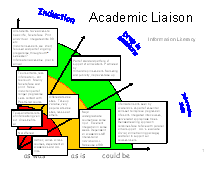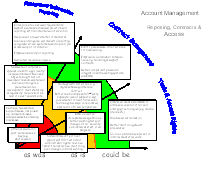Approach
Our experience has shown that there are a number of approaches to change management and process (re)design and business process re-engineering.
There are many facets and layers of these approaches and a mix of appropriate methods but a clear layered structure to the steps for successful change is often required. Our experience contains elements of all of these steps and familiarity with a number of tools designed to expedite each stage.
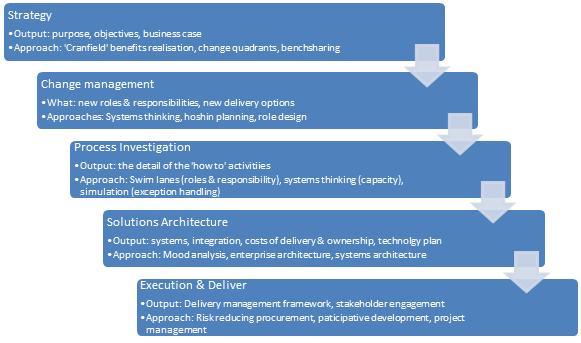
Much of systems investment is predicated around automating old methods, and it is frequently a recipe for inefficiency. At best, it simply fixes existing processes but locks them in time. At worse, it precludes any savings from technology.
Our proposed approach is also based on our considerations of client as a ‘brownfield’ site because whilst some new capability is required, all interventions need to sit within an already established base of systems and practice.
For a ‘brownfield’ study, we are often able to use an abbreviated analysis to fill in any potential ‘gaps’ that may exist in systems, processes and practices etc.
In addition, our experience in recognising the source and cause of commonly presented issues, suggests that the following areas of concern often arise:
-
Objectives: An absence of a shared vision and remit – leading to divergent activities and priorities.
-
Focus: Poor quantification and understanding of high volume, high return activities – leading to the ‘tail wagging the dog’.
-
Systems: Inappropriate technology support – either through inherent technical problems or problems derived from customisation and data structures
-
Processes: Inefficient and ineffective processes and multiple delays and hand-offs.
-
People: Inappropriate working patterns and responsibilities.
-
Skills: Process knowledge and user training insufficient.
Our approach, outlined below, is derived from the ‘Cranfield’ methodology designed initially for new system initiatives but which puts process improvement at the heart of systems change. Fully delivered, it ensures that systems change and investment is driven by qualifiable process efficiency and effectiveness which, in turn, provides ‘hard’ performance targets for those providing the service.
We have used the whole methodology most recently at a major UK University for a large systems improvement programme to support the estates and facilities operation. When the systems funding was cut our work still delivered 60% of the planned savings outlined by our project.
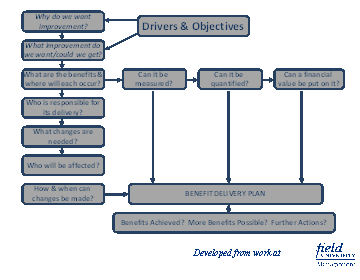
The approach will focus on the definition of drivers and objectives in order to define a detailed set of existing ‘as is’ process maps as well as the highlighting of particular problems areas. In particular, it will ensure that specific options for desired change are outlined and assessed, in order to define a detailed ‘Benefit Delivery Plan’. The Benefit Delivery Plan will also outline benefits, consequences, timescales and resources required to undertake the planned changes.
Discovery
This stage would involve initial investigation and definition of potential drivers and objectives, along with an exploration of how higher-level University objectives and strategy informs the examinations/assessment and progression administration functions.
In addition, this would also involve the definition and prioritization of the key business processes and sub-processes to be explored, as well as the selection and agreement of the appropriate tools and techniques to be utilised during the subsequent stage of the review (e.g. swim-lane diagrams, RACI diagrams etc.)
‘As Is’ Process Investigation
This stage would involve a series of workshops and interviews with key stakeholders to define ‘as is’ process maps, along with the exploration of key problem areas and the consequences of doing nothing.
Options Assessment and Benefit Delivery Planning
Further investigation would be undertaken to define the Benefit Delivery Plan – outlining important options for change and, for each option, detailing the benefits and consequences of the change, along with the time and resources required to achieve the desired benefits.
Closure and Review
Finally, we anticipate the last stage of the BPR Review focusing on the highlighting of key recommendations for change as well as the potential definition of outline roadmaps for achieving the desired level of change defined. This stage may also involve presentations to key stakeholders and senior management.
Process and Sample Outputs
In what follows we will include sample outputs, which will illustrate the types of analysis techniques and the type of findings, which could be produced by our study.
Context Exploration
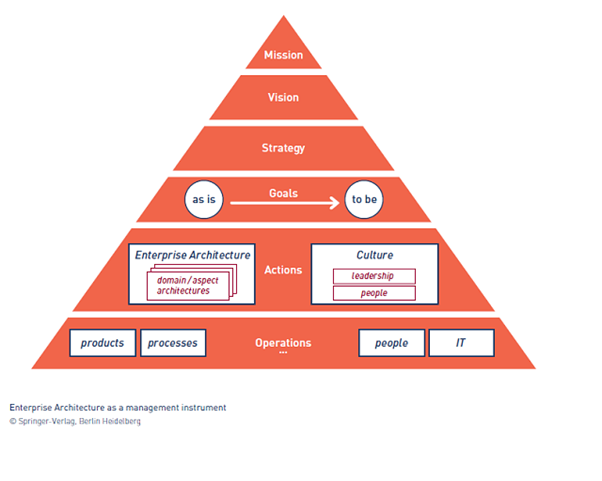
Current performance is usually determined by the set of strategic decisions and goals operating at a higher level, which define the operation of the institution and influence the functions under consideration. As outlined in our approach summary, our initial Discovery phase will focus on establishing the significance of these for the functions, as well as defining the list of key business processes and sub-processes to be mapped.
Benefits Analysis and Benefits Mapping
Once the vision, goals and objectives for the BPR review are established, the ‘Cranfield’ benefits dependency network may also be developed.
Two examples follow – one for an estates information systems which is quantified and costed, and a second for an Intranet where many of the benefits are qualitative. Both show the integrated scope of the system and the importance, and value, of key elements (illustrated by the width of the tie lines).
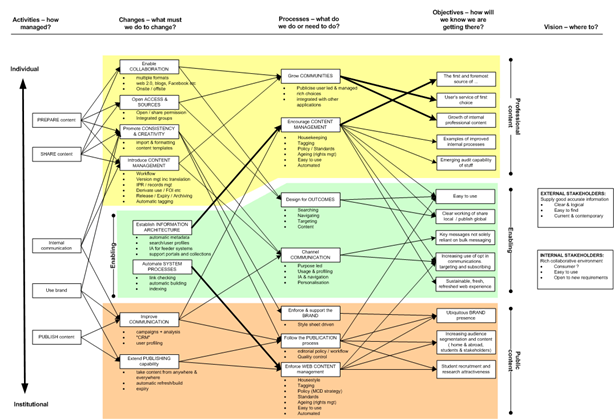
Qualifying Change
Based on a framework for strategic change and the resources and ambition for improvement, we can start to understand the potential for change. Our preference is to use an interactive technique ‘quadrants’ with the individuals currently responsible for the activity.
In addition to the reason for strategic change is the desire for strategic change, of many participative techniques one of the best is the use of the future quadrants. Simply by looking at the aspects of a function, through the services offered, and plotting an ‘as was’ picture, the ‘as-is’ capability and the ‘to-be’ aspiration many process development activities become apparent.
The example below comes from a review in library services and IT service provision. The technique is remarkably simple to use, effective and is usually greatly enjoyed by participants.
|
|
|
The use of a ‘before’, ‘current’ and ‘future’ assessment technique recognises the ambition of the team developing the function but also the existing capability for change. For example, if the ‘could be’ is highly speculative and the ‘was/is’ profile has changed little this might indicate that future change might more difficult than anticipated. Alternatively, if the ‘was/is’ picture shows significant development, this would auger well for future change.
Roles and Responsibilities
An extremely important dimension in the investigation of current and future business processes is that of ‘roles and responsibilities’. This kind of analysis seeks to understand and visualise current activities (e.g. “how many people does it take to change a lightbulb”) and then to identify changes which streamline processes. Principles from ‘The Boundaryless Corporation’ may be adopted in order to demolish internal walls and making processes work with as few roles as necessary.
The primary techniques for this derive from swim-lanes diagrams, and an example of this is provided below:
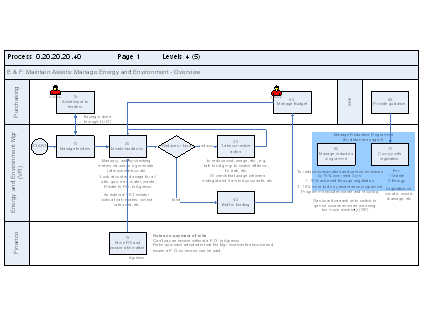
Our experience is that whilst swim–lanes provide the high level approach, Role Activity Diagrams are needed to expose the details ‘inside the box’. That is, whilst the box may say ‘IT provide accounts’ it is often necessary to explore the steps of the seemingly simple processes of granting an account. It may, for example, include many hand offs and stages.
Also, if a significant component of the institution’s works is handled by external agencies a further refinement RACI analysis may be required as follows.
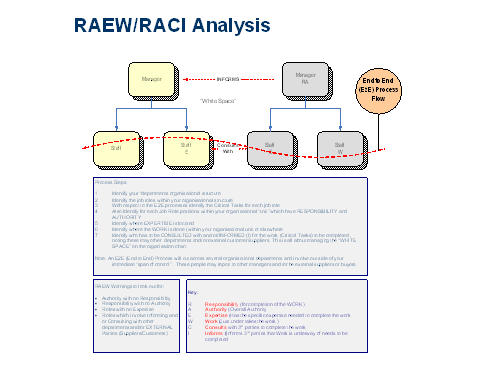
Understanding Systems Fit
The final element of the analysis is to understand how well the existing systems ‘fit’ the current patterns of work. Detailed results of this analysis may, for example, be presented as a systems map as follows:
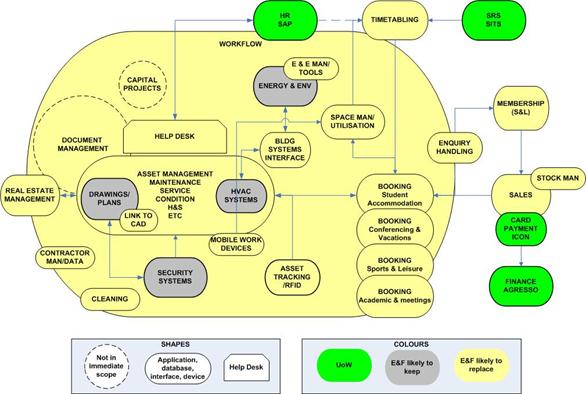
Moving Towards Change
Finally, examples of the output of benefits management and benefit delivery planning activities are provided below.
|
Key benefit |
Description |
Metric |
Target |
Date |
|
Maintenance |
Cost saving: proactive interventions avoiding expensive call-outs by maintaining during working hours and/or using alternative facilities Cost saving: economies of scale, better supplier management, contracts, etc. – more planned and less reactive maintenance. |
Budget reduction (per m2) for maintaining estate (doing the same for less):
|
£180k pa
£200k pa (£380kpa total) |
From 10/11
From 10/11 |
|
Space |
Cost avoidance: better utilisation of teaching space. Space management cost avoidance for non-teaching space is not quantified |
Cost equivalent (new build v refurbish) of space released
|
£4,200k £1,600k (£5,800k total) |
Both from Aug09 to Jul13 |
|
3rd-stream income |
Revenue: increased third stream income from better visibility of potential Revenue: prevention of membership and hirer attrition / facilitation of additional sales. |
Increased revenue from sales
|
£70k pa £30k pa £50k pa (£150kpa total) |
From 10/11 From 10/11 From 10/11 |
|
Efficiency |
Cost saving: help-desk centralised. Cost saving: temporary staff of based on not employing 3 temporary staff for 4 months each. |
Helpdesk staff costs
Non-academic booking temporary staff costs |
£60kpa
£24kpa (£84kpa total) |
From 10/11
From 10/11 |
